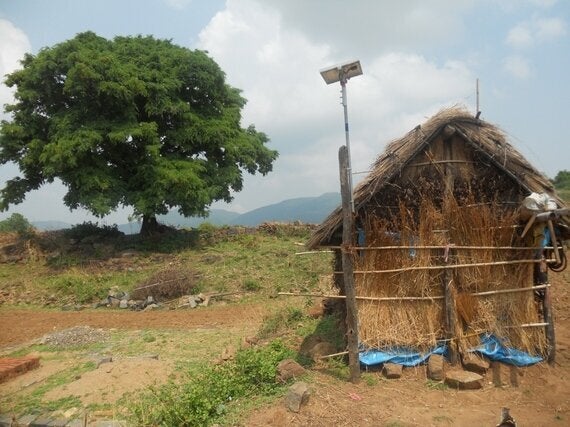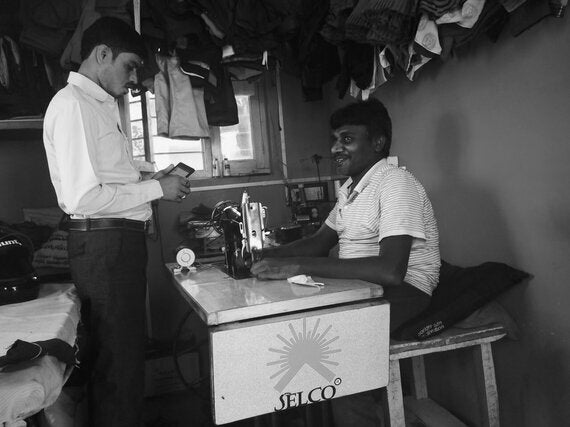Policy inputs by SELCO Foundation Policy Team
Photo Credit: SELCO Foundation
On 1 October 2015, India announced its new climate plan via the Intended Nationally Determined Contribution (INDC) with the following major commitments by the year 2030:
•To lower the emissions intensity of GDP by 33% to 35% by 2030 below 2005 levels
•Increase the share of non-fossil based power generation capacity to 40% of installed electric power capacity
•Create additional (cumulative) carbon sink of 2.5-3 GtCO2e through additional forest and tree cover
This commitment represents a transformational shift in the sub-continent's earlier stance in international climate change discourse to a leadership position given its growing population and economy that will have significant impacts over the next decade on the environment. With an economic growth of 8-9% and a population of 1.3 billion people, India's per-capita emissions would increase from 1.6 tonnes to 3.6 tonnes per year. If India were to use the same amount of energy per unit of GDP in 2030 as it does now, then emissions would top 6 billion tonnes by 2030. India is on the way to becoming the biggest contributor to increases in greenhouse gases within 15 years -- India is currently at a crossroads and has the potential to change it's trajectory to a low carbon future with congruent economic and environmental goals.
India's climate plan is of vital importance but there is much needed clarity to outline the details of this strategy to align with broader goals of inclusive development and poverty alleviation. Thus executing this plan to truly benefit 250m-300m Indians who live without access to energy. India has more poor people than anywhere else in the world: 230m living on $1.90 a day or less--the World Bank's definition of extreme poverty.
SO JUST HOW VULNERABLE IS INDIA'S POPULATION TO CLIMATE CHANGE IMPACT?
• More than 60% of India's agriculture is rain-fed, making the country highly dependent on groundwater.
• Most Himalayan glaciers have been retreating over the past century, sending less water to rivers that feed hundreds of millions of people downstream.
• A quarter of Indians live near coasts that are vulnerable to sea-level rises. Mumbai has the world's largest population exposed to coastal flooding, with large parts of the city built on reclaimed land, below the high-tide mark. Rapid and unplanned urbanization further increases the risks of sea water intrusion.
• Additionally, Thirteen of the world's 20 most-polluted cities are in the subcontinent.
• Smoke from cooking with wood or dung in Indian homes may be responsible for 500,000 early deaths a year, mostly of women and children (World Bank).
India's Intended Nationally Determined Contribution document has succeeded in listing out all the different initiatives under government departments where a component of energy intervention or reduction of carbon footprint is included. In the process the focus is predominantly on urban and well-connected regions, while the opportunity to reflect on how the 68.80% of the Indian populace who reside in rural and remote areas can get access to clean energy and how can their development can be reconciled with emission reductions is missing. There is a need for a paradigm shift in the lense with which India approaches reduction of carbon emission and adoption of clean energy forms. This article highlights two ways in which India can strengthen her climate plan roadmap that is inclusive of the poor.

Solar home lighting system in rural India
CROSS SECTOR CONVERGENCE WITH ENERGY ACCESS
Recent policy rhetoric towards cities has been shaped by their increasing economic importance without adequately considering environmental factors, for example the "100 smart cities" plan to improve urban design and infrastructure. There is a need to stop looking at cities as 'engines of growth' but rather look at cities as 'engines of inclusive sustainable development' especially in light of the aforementioned climate change risks and threats India is under. While the INDC alludes to inter-linked initiatives in health, urban planning, skills and so on, it will be critical to ensure that the Clean Energy aspects of Climate change mitigation are approached from a "Cross Sectoral Perspective" as a critical lever to interwine the goals of development, poverty alleviation and low carbon growth
Energy poverty and unreliable access are gripping issues affecting the availability and quality of basic health facilities, education, water and sanitation, livelihood development, housing etc. India has several Government programmes that are spread across various sectors such as the Indira Awaas Yojana (low cost housing), Saansad Adarsh Gram Yojana (MP's model village scheme), National Rural Livelihood Mission, Health Mission and so on. The Government should create plans for convergence to ensure the energy needs for their own deliverables are met through a low-carbon pathway and thus strengthen India's INDC efforts.
STRENGTHENING THE ENERGY ECOSYSTEM AND LIVELIHOODS
Currently India spends about half of its foreign-exchange earnings on fuel imports. Despite being the world's third-largest coal producer, India imports a fifth of its coal, and imports four-fifths of its oil due to it's ever growing demands. Additionally, the cumulative effect of 1.3 billion people using kerosene and other biofuels for lighting contributes heavily to global carbon emissions. Although it is important to recognize that on a per capita basis, these segments remain at the bottom of the spectrum of CO2 emitters.
The LED push, under the Domestic Efficient Lighting Programme, was launched in 2014 in Maharashtra, Rajasthan, Delhi, Uttar Pradesh and Himachal Pradesh. Nearly two crore LED bulbs have been distributed in these states and the project's ambition to reduce power consumption, increase domestic savings and trim carbon emission is already seeing results. It has been an important initiative towards addressing energy efficiency. A staggering 68 lakh kilowatts of energy is saved every day. This includes a cut in 645 megawatts of power during peak hours, a 5,520-tonne drop in daily carbon emission and domestic savings of Rs 2.71 crore or 270000 GBP every day .
Despite, the improvements linked to energy efficiency in lighting, there are still questions around energy-intensive small livelihoods in rural and urban settlements. 10m-12m young Indians entering the labour market each year. A crucial lever for poverty reduction is livelihood which in turn relies on energy for product development, efficiency and value addition and an environment conducive for people to want to pursue and sustain local livelihoods. Rural India is replete with communities who need customized decentralized renewable technologies (DRE) that are compatible, accessible and affordable and result in increased household incomes. Improvements in energy efficiency of technologies for small, rural livelihoods - weaving, flour mills, water pumps, tailoring, refrigeration- combined with DRE solutions could address the power shortage issues of a large set of livelihoods whose energy needs are on the rise and critical for their productivity.
This requires a thought shift in India's approach towards integrated renewable energy policies, placing equal importance on strengthening the "Ecosystem Factors" such as credit, technology and capacity building that create an enabling environment to sustain livelihoods and unleash entrepreneurial potential to generate sustainable means to livelihoods.

Solar sewing machine in Karnataka, India
In conclusion, India could set an example in the adoption of low carbon pathways towards the twin goals of development and climate change adaptation through two key paths - incorporate decentralized renewable energy solutions that are specifically targeted towards the under-served population into the government's development policies across all sectors of energy, infrastructure, health and education; foster enabling conditions and ecosystem development for livelihood generation and greater standard of living This would provide an opportunity to substantially add teeth to current commitments while meeting India's own developmental goals.